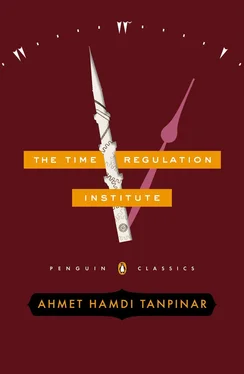As my son teased me about the building and its pillars and stairs, I looked at his eyes, which were dark like grapes, and his thin lips and his stubble of a mustache slowly altering his face. I thought of all the things that made him so different, this fragile little man who was a part of me, who helped me as a friend, yet never fully opened himself up to me as he glided over so many of his thoughts. It did not upset me in the least that he didn’t take after me, that in his mind he rejected me. I harbored no resentment. I knew that his only salvation was in being unlike me, and that was fine by me. Indeed it even made me happy. But I wondered where he found his strength. Here was the last man in the line of Ahmet Efendi the Some Timer — what had driven him to this point? I was, nevertheless, truly surprised to find no anger or hatred between us. I took this to mean that my son had not just overcome close family ties and the comforts that came with our new wealth and prosperity but that he had also taken on a far more difficult challenge: he had overcome himself.
Suddenly my mind went back to the years after Emine’s death, when Ahmet and Zehra would wait for me on the front stoop every night, fighting tears as they embraced each other in desperation. I felt the tears well up in my eyes. If I’d had the courage, I would have told him everything and asked for his forgiveness. But Ahmet had become that lycée student who, after completing his studies with due seriousness, erases all problems from his mind, and so he left me no opening. At one point, I asked:
“How are you getting on with your sister?”
A beautiful light shone in his eyes.
“I love her very much,” he said.
Then his hand rose to his chest and gently tugged on his sweater.
“She knitted this for me.”
We fell back into our usual silence. I thought that although my son was right there before me, we had again drifted far apart in our thoughts. With the end of our shared project, the chasm between us reopened. Once again I became a man he would only visit if I was ill or by appointment.
What a terrible thought, and what an impenetrable maze. “Perhaps to become his own person,” I told myself, “he has no choice but to forget about me, yet only through him do I feel remotely like the person I should be.” Perhaps this was something he’d never understand. He’d guessed that my run of good luck would soon be over, and he was right. But I could only tremble helplessly as I watched his life unfold.
There would always be a chasm between us. Every so often we would extend our hands to each other, only to return to our separate worlds; meanwhile my heart filled with bitterness and his with hope. Such were the poignant thoughts that weighed on me during the night we spent together. When morning came, I would be a different man, as I stuffed the matchboxes into a basket and marched off to work. And perhaps the very next day I’d meet with thundering applause. Halit Ayarcı would have to pay through the nose for the pleasure he’d taken in angling for the upper hand. And that wasn’t all. Tomorrow night was my night with Selma. Once in her arms, I’d forget everything. And in two or three weeks’ time, I would perhaps sleep with that young girl Sabriye Hanım had offered me as a gift; Sabriye had been holed up in the institute for three months and was keen to cause trouble for Pakize and Selma. This was yet another way to forget, and to change. And just the other day I had quite an interesting talk with Seher Hanım over afternoon prayers. I’d left knowing I’d not be able to neglect that woman any longer. I was doomed, therefore, to sink into the bog of forgetfulness I’d claimed as my own, and to forget. Never again would I experience such joy as I did over the three months I spent working on the clock building.
All this had come of a single event. None of this would have happened had Emine not died. As if hearing my thoughts, my son stood up slowly:
“There’s no need to worry,” he said. “I’ll come visit you more often. I’m strong enough now.”
And for the first time he gave me a genuine kiss. He had accepted me for who I was. I watched him as he left the room. And I thought of the girl he might have been in love with then, or perhaps the one he’d fall in love with in the future. I thought about his fate and fortune. Every child breaks with his father at that age. But my child had done so twice. That night, as I lay in bed, I thought of our old, humble home. I kept remembering the geranium that a tiny Ahmet had planted in a broken-rimmed pot that hung from our crumbling bay window. Every now and then I shivered in my bed, but I was pleased to know that I would see him one more time, at breakfast, in the morning.
II
Halit Ayarcı greeted my project with much enthusiasm, or rather he welcomed the strange architectural model made of empty matchboxes I had constructed in accordance with my son’s entirely unprofessional designs. With each new detail I explained, his delight rose to new heights. When I finished, he leaped to his feet to offer me his heartfelt congratulations. On several occasions, I reminded him:
“But let’s not be too rash! There’s still so much to do, and so many flaws in the design. We have twelve large meeting rooms and forty smaller rooms — how shall we ever fill them?”
He wasn’t even listening.
“My good friend,” he said. “There is no need to disparage your wonderful work. You’ve done a sterling job. The hardest part is behind you. This central hall has been bothering me for the last two months now. And here you have hit upon a capital solution!”
“But that’s not at all what I mean—”
“By now we should no longer need to share all our thoughts — we should understand one another implicitly! We each made the same mistake, basing the building’s design on a pocket watch. But then we remembered the Blessed One instead and presto! Everything changed. But you have surpassed me. As for the meeting rooms and offices, there’s no need to worry. We each have plenty of relatives and then, of course, there will be the others who come recommended, not to mention the people in the regulation stations who will wish to be promoted. What I’m trying to say is that an empty office or meeting room will find its own function, much in the way that a civil servant’s function is guided by his title. And this spot you’ve set aside for Sabriye Hanım — it couldn’t be better. How happy I shall be to see our dear friend perched at the top of the building, in her very own eagle’s crag! But we’ll think about these things later. Our next step is to arrange a press meeting, to alert the public to your achievement.”
Of course a good many of my readers will remember those pictures of me posing before the outlandish and frankly grotesque model I had made out of detachable and expandable matchboxes — for why not admit now that the game was up. Even as I was applauded so vigorously for my building and its model, I was being subjected to criticism just as loud: it was perhaps fitting that I became known as something of charlatan, a cross between an amateur genius and a fraudster. But by then I’d become used to such things; those who looked kindly on innovation were enthralled with the novelty of the main hall’s four ornamental pillars and the entirely original way in which different stairs ran in and out of the different floors of the six o’clock pavilion. One friend of mine praised me lavishly in the paper almost daily: “Innovation! From top to bottom, unfathomable innovation beyond our wildest dreams! Three cheers for innovation!” Another friend praised us for “our departure from dusty classical forms.” And to quote a third commentator, who had earlier heaped me with praise for my unusual staircases and the two unnecessary bridges connecting them to the main building, the ample space left between three pavilions was only to allow for these: “As a new era of Turkish syntax dawns, a new architectural language has been given voice. Let’s see what those opposed to inverted syntax will say in the face of Hayri Irdal’s resounding success!” The fourth critic was even more ebullient. In his view I had not just designed a building worthy of inverted syntax: I had also created a work of abstract architecture. As for my matchbox model, it had a clear effect on the market. As the new architectural language took root, the state monopoly of matchmakers struggled to keep up with demand. We issued regular statements to the press that only served to add heat to the debate. And when I declared that I’d paint each pavilion a different color, the discussion lit up like a bonfire.
Читать дальше












